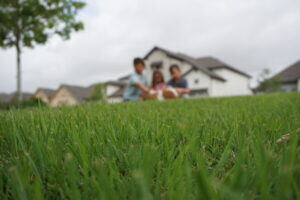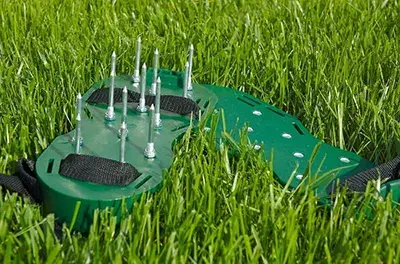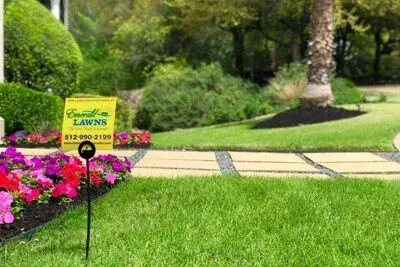Proper drainage is essential for maintaining a healthy and vibrant lawn. It prevents the formation of standing water that can damage your outdoor spaces. It also safeguards against soil erosion, reducing soil and nutrient displacement.
The unique soil types and climatic conditions in the Dallas Fort Worth area can pose significant challenges to lawn care, causing poor drainage and destroying lawn systems. In this guide, we’ll explore the detrimental effects of poor drainage on your lawn and provide practical solutions to address these issues.
Understanding Drainage and Its Importance
Lawn drainage refers to the ability of soil to absorb and move water away from the surface. It ensures that water from rain or irrigation infiltrates the soil efficiently, preventing excess moisture.
Proper drainage is vital for a healthy lawn. It prevents waterlogging, which can suffocate grass roots and lead to various lawn diseases. It also ensures that water and nutrients are distributed evenly, promoting robust grass growth and minimizing soil erosion.
However, it isn’t uncommon to hear about poor drainage ruining lawn systems in North Texas. You will find different soil types in the area, from heavy clay to sandy loam, which can significantly impact drainage. The region also experiences extreme weather conditions. All these factors together contribute to poor drainage of lawn systems.

Signs of Poor Drainage in Your North Texas Lawn
Homeowners and property managers should pay attention to the following symptoms of poor lawn drainage and take immediate action when they are observed.
Standing Water
If you always find puddles after rain or irrigation, this is a clear indicator of poor drainage of lawn. Standing water can suffocate grassroots and create an environment conducive to disease.
Waterlogged Soil
According to researchers from Oklahoma State University, soil has a threshold that allows water to drain using gravity. When that field capacity threshold is reached, the soil remains soggy and squishy for extended periods, indicating inadequate drainage.
Yellowing or Wilting Grass
Excess water can lead to nutrient leaching, depriving grass of essential nutrients. Grass turning yellow or wilting despite adequate watering is often a sign of poor drainage.
Thatch Buildup
An excessive thatch layer, a buildup of dead grass and roots, can indicate poor water penetration. Thatch prevents water from reaching the soil, making drainage problems worse.
Moss and Algae Growth
This condition is another clear indicator of poor drainage destroying lawn systems. The presence of moss or algae suggests persistent moisture and inadequate drainage.
How Poor Drainage Damages Your Lawn
Finding a property’s lawn ruined because of poor drainage isn’t uncommon in North Texas. When not properly drained, water can oversaturate the soil. Long-standing water on your lawn impacts the health of the plants, shrubs, trees, and grass, making professional lawn care services essential.
Consider the effect of poor drainage on your property:
- Root Rot: Root rot occurs when grass roots are submerged in water for too long, causing them to decay severely impacting grass health.
- Soil Compaction: Compacted soil restricts root growth and water infiltration, creating a hard, impermeable layer, causing poor drainage and ruining lawn systems.
- Nutrient Deficiencies: Excess water can lead to nutrient leaching, where essential nutrients are washed away from the root zone,
- Increased Disease and Pest Problems: Wet conditions foster the growth of lawn diseases like fungal infections and attract pests that thrive in moist environments. These problems can damage landscaping and softscape, with poor drainage destroying lawn grass, plants, and other greens.
Diagnosing Drainage Issues
To diagnose drainage issues, observe your lawn after watering or rainfall. Look for signs of poor drainage ruining lawn plants. These symptoms include the ones mentioned earlier, such as persistent puddles and waterlogged soil.
Use tools like soil probes to assess soil compaction and moisture levels. You can also call professionals to perform a percolation test, measuring how quickly water drains from a hole in the soil.
If drainage issues persist despite your efforts, consider seeking professional lawn care services. These experts can provide comprehensive assessments and recommend targeted solutions.
Solutions for Poor Drainage
Consulting lawn care specialists, like those from Emerald Lawns, can help provide fast and efficient lawn care and maintenance, improving soil drainage.
They offer the following solutions tailored to your specific needs.
- Liquid Aeration: Liquid aeration improves soil structure by breaking up compacted soil, allowing better water infiltration and root growth, and significantly enhancing lawn drainage and overall health.
- Organic Topdressing: Topdressing with organic materials, such as compost, improves soil composition and drainage and adds beneficial microorganisms and nutrients to the soil.
- Irrigation System: An efficient irrigation and sprinkler system ensures that your lawn receives the right amount of water without contributing to drainage issues.
- Installing Drainage Systems: Effective solutions for severe drainage problems include installing drainage systems like French drains, dry wells, or swales.
- Improving Soil Health: Adding organic matter and soil amendments can improve drainage by enhancing soil health. Organic matter increases soil porosity, allowing better water movement and root growth.
- Reshaping the Landscape: We provide leveling services to reduce the risk of soil erosion, and prevent water pooling and flooding. Our team uses custom-built equipment to distribute sand evenly across the affected areas.

Preventive Measures
Regular lawn maintenance practices are crucial to preventing drainage issues. Homeowners and property managers must monitor lawn conditions and adjust as needed, especially during seasonal changes. Implementing best mowing, watering, and fertilization practices can also help maintain proper drainage.
Expert Lawn Care Solutions from Emerald Lawns
Preventing poor lawn drainage is essential for a healthy, resilient lawn in North Texas. By understanding the signs of poor drainage and implementing practical solutions, you can protect your lawn from the detrimental effects of excess water. Taking proactive steps to identify and address drainage issues will ensure your lawn remains vibrant and beautiful throughout the year.
If your lawn is ruined because of poor drainage, it may be time to call in professionals. Emerald Lawns specialists can help. Our team serves residents from Austin, Temple, San Antonio, and the Dallas—Fort Worth area. Call 888-356-7717 or contact us online to get a quote.


.png?width=1142&height=1350&name=Holiday%20Decor%202025%20LP%20-%20548x648%20%20(1).png)


